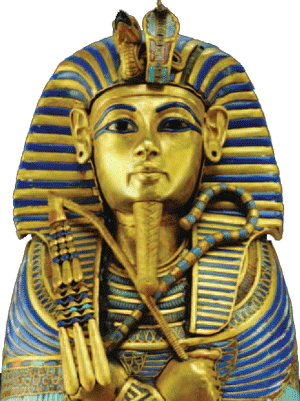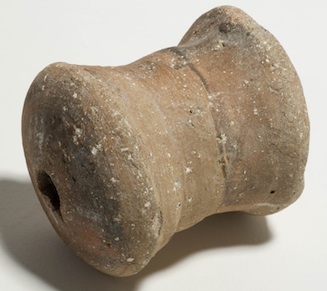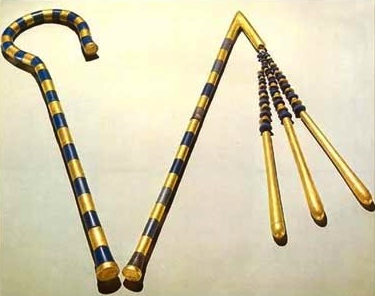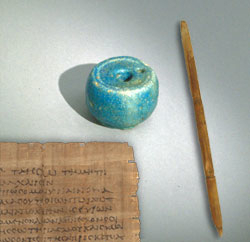
Detail from the outer golden sarcophagus of Tutankhamen. On the head, the Vulture is on the right, and the Cobra (Uraeus) is on the left. Crossed at the the solar plexus (a traditional death motif), the right hand holds the crook (a rod with a ring) and the left holds the flail (a rattle). The common associations are Shepherd (crook) and Provider (flail as grain-thresher). Both symbols are linked to Osirus.
&@ . ~ o ~ . #^
RattleRod : Question
Emanation and reception are crucial aspects of many sensory paradigms. There are two obvious modes which appear to represent something analogous to a gender pairing: (reception)penetration and emanation(reception). These take physical form in two of the oldest and most common artifacts of human cultures the world over: the rod and the rattle. A simpler form of this same pairing is perhaps more obvious: rod and ring.
~ ; • [ ~
Consider the blind person’s common physical replacement for seeing while walking: the cane. A simple rod is passed back and forth in an arc before the walking person, forming a comparatively primitive analog of the concept we use in our radar and sonar technologies. Emanation and reception.
The movements of the mind of the person holding it are the primary emanation1, the movements of their body secondary, the movements of the cane, tertiary. What comes back to them across the physical transport of their staff is relatively focused information about their environment — particularly, information related to possible obstacles or, in some cases, opportunities.
Occasionally throughout human history a blind person located treasure which if not for their peculiar mode of insight might have gone unnoticed. Although the physical form of this discovery is relatively rare, it turns out that ideological and relational instances are far more common; in some cases, more common than amongst those whose eyes work adequately. Alas, this may be the very cause of their inward blindness; the inherent charisma of the sense we call sight is so overpowering that, it is prone to blind us to inward characteristics of value, wonder, and even awe. How many times have we heard adages and clichés regarding the cover of a book or superficial beauty’s common deployment as a lure used by predators?
The rod is a way of knowing whose powers rely on touch and penetration, and, in general, its targets are specific. Missiles such as the arrow and bullet are progeny of this metaphor, and many of science’s primary methods emulate it. To know, penetrate.
Even the Bible appears to equate knowing with penetration; the ruffians outside of Lot’s house in Sodom demanded that he eject the angels visiting him that they could be ‘known’, which, in this case essentially meant to be raped. Lot, unwilling to capitulate, offered his virgin daughters instead. Apparently those without had no interest in the substitution. But it is here that we begin to see that the common understanding of knowing was directly related to penetration. How many times have we heard it said that science ‘penetrates’ nature’s mysteries or that an uncommon intelligence is ‘penetrating’?
The specificity of the rod’s power should be obvious; generally it touches a single thing or being or circumstance at a time, and reveals something specific about it. Location, size, hard or soft, smooth or rough, slippery or granting purchase, &c. Touch one thing, get one answer.
Yet the rod has many other functions than tapping. With it, one can measure, and thus it could be said, one can rule. It is almost the physical analog of a serpent, and it is the tool of the scribe, as well as the king. Bend one end into a rough circle and you have the shepherd’s crook — an implement so ancient and yet still so common as to prove the value its ordinary appearance belies. This implement served as a weapon, an extension of the arm, a way of capturing an animal, a drawing implement, and a source of improvisation whose capacities are nearly endless. Of all the things that might be carried, shepherds the world over chose the crook. The marriage of the rod and the ring.
And the pharaohs of Egypt are often shown holding this object in their right hand which is associated with the left hemisphere, language, and the waking-state intelligence.
Tthere are far deeper associations than those we find easily available to our imaginations. As one example, the ruler is the one who is endowed with the capacity for correct measurement, and this capacity is only available to those who are the agents of the divine. In such a case, this simple stick becomes more like what we understand as a lightning rod, attracting and focusing the divine energies into its rightful wielder. The rod’s focused receptivity, though subtle, must not be overlooked.
Oh, and by the way, do you recognize this symbol [ ? ]
,< . ~ o ~ . [_

An ancient rattle from the Middle East
There is another way to see while blind, which is to emit sound, and await its return. Some youths and some few adults have adapted to blindness by learning to emit clicking sounds, with which they can rapidly discern a great deal about their local environments — far more than would be available with a cane. But the paradigm at play here is far older, and related to the rod’s natural compliment: the rattle.
The rod and rattle comprise an excellent duet. The rattle, when agitated, touches everything around it with sound. The effect is profoundly inclusive, and reverses the rod’s specificity — to an almost perfect generality. The picture that comes back to the sensitive instigator is vague in comparison to the rod’s direct singular contacts, but vastly broader in scope. In terms of a paradigm to replace sight, the rattle is far superior.
Still, a combination of the two paradigms, intelligently deployed, might suffice to supercede the powers of either alone…

Crook (17/17) and flail (9/9).
These symbolic objects appear in a wide variety of contexts in Egyptian art.
On Tutankhamun’s external sarcophagus he is depicted with his arms crossed. In his left hand he holds what we commonly call flail, and while modern archeologists still debate what precisely this object is for (some say a fly whisk, others a wheat flail, others a device for extracting aromatic gum from certain plants), it is immediately obvious that if agitated, it would rattle.
The left hand is associated with the right hemisphere, generality, receptivity, and the dreaming-state consciousness which is dominant during sleep or trance-states. When agitated the rattle’s sound flows outward in what is essentially a spherical (or ring) pattern, touching everything at once in the local environment. The results are reflections and absorptions. which, upon their return (or lack thereof) to the source comprise a sensory paradigm. While it might seem general in comparison to the rod, the rattle provides far more complete information about many ‘targets’ at once.
But it can also be used to threaten or warn. Although not as penetrating as a physical weapon, the rattle’s sound is startling, and penetrates the psyche, rather than the body. Many who have explored the wilderness in person have learned of this power, using it to rebuff the approaches of a variety of predators, including bears, lions, and other powerful hunting animals. The rattlesnake is the primordial exemplar: a living rod whose tail is a rattle.

While a physical injury may enrage an inclement predator, fear will almost surely cause them to depart. In this sense, the rattle is an adept physical metaphor for the feminine power of rebuffing advances — one which has certainly been practiced in nearly every circle of life from time immemorial.
The crook and flail are not the best or only examples of this pa(i)radigm, but they are visually amongst the most famous. The antiquity of this pairing vastly precedes the establishment of civilization itself, and probably reaches so far back into the development of our species as to comprise some of our earliest ‘inventions’.

Egyptian pen, inkwell and papyrus.
The pen and inkwell form one of the most direct metaphors of the unity of rod and ring.
Note that the inkwell ‘contains blackness’, which, the pen, when dipped in, can use to express its opposites: is-ness, structure, memory, and image.
Matter has positive energy, but gravity has negative energy.
Is gravity the ink with which matter is incribed?
One and Zero : Rod and Ring
The rod that supports the elderly or aids the blind is a common enough sight even in modern contexts, however the profound ubiquity of this in human engineering is rarely explored. The rod and the ring are married, and although the beginnings of this marriage are lost in antiquity, their progeny are everywhere in common evidence.
The most obvious instance is perhaps the axle and wheel. The gear-shift is a rod that meets wheels, and the ‘steering wheel’ is a ring attached to rods which allow the driver to intricately adjust the angle of the front wheels.
The pen and pencil are both elaborations of this paradigm, which was elaborated into little circles with symbols on them which were attached to rods to form the input structure of early typewriters.
The key fills a peculiar gap and allows inward rotation — a mechanical version of the electronic ‘password’ which comprises an identification prerequisite for entrance to a home, or car — or box containing something requiring protection. The same principle is used to begin the processes of ignition for nearly any common motor vehicle.
The wheel itself is spoked, again illustrating the profound necessity of the line and circle. Even our number 10, which marks the place of repetition, or the set, is a visual representation of precisely this relationship. Our remote-controls for our televisions are rods with circular emitters in their foreparts, and those with which our military now control deadly robotic assets are rods sticking up from spherical controllers.
We call them joysticks.
,< . ~ o ~ . [_

1 and 0: Lightning and Tornado
Father, Mother, Space: Trinity
If we will admit the masculinity of the rod (a schema implied by our anatomy) I ask you to consider the femininity of the rattle (which is the active expression of the ring). Many traditional male roles include an emphasis upon travel, strategy (attack / defense) and hunting (discovery / penetration-killing).
Many traditional feminine roles include an emphasis upon remaining local to the home, gathering, herb-lore, weaving, and insuring the health of home and children (attraction / envelopment metaphor).
Men, somewhat like the sperm they carry, are considered relatively expendable compared to women, who carry eggs and produce single candidates for fertilization approximately once per month in humans. Women are generally protected from harsh situations; there are few cultures in which the women hunt, and many in which they gather vegetation and materials for textile production. These roles, along with their uncommon exceptions, appear to have shaped the evolution of the human genders for thousands of years.
While these common cultural interpretations may be construed as sexist, it is hard to get around the fact that the woman’s body is our first home. It’s not much of a stretch to call her wom(b)an. Man comes forth from this womb in part as woman’s agent: to bring her (from afar) what her maternal nature and character require in order to be more of what she will. In primates, it appears common for the man to ‘travel’ and search out the woman, who either ‘rebuffs’ (deflection) the approach or ‘receives’ (authorizes) it. Yet, once coupled, both are capable of participating in attraction (of allies or resources) and deflection (of threats).
If we allow that the paradigm of energy (invisible, penetrating) is masculine, the feminine is surely matter (visible, inviting) — a term which derives from the Latinate ‘mater’ — meaning mother. The combination of these forces is fertility and leads to endless expressions in our environment and as living children.
Our local astronomical situation sheds further light on this relationship. It is not the Earth that pulls the planets through interstellar space, it is the Sun; the source of penetrating ‘rays’ of light and energy whose overwhelming output literally create wind in space. But Earth’s attractive (but survivable) ‘gravity’ pulls resources to her and her children (as well as making children possible), and her moon is capable of rebuffing or even in some cases deflecting incoming material. The relationship is mutual and complimentary, not biased. The planet is a home. The star vitalizes, fertilizes, and illuminates her. Earth reflectively expresses their union in both their children and her incredible ‘blue dress’ which the Sun’s illuminations highlight daily.
On either side of the trunk of tree, the beneath and the above, the roots and branches achieve a vague sphericity…
Mess with the Bull? You get the Horns.
Mess with the Whale? You get the Tail.